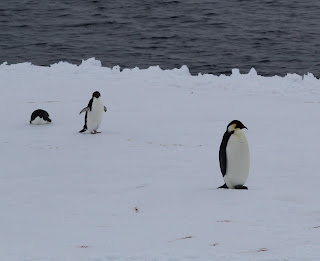So once more onto the bridge ... and with great results !
Having become quite familiar with Antarctic prions the next prize would hopefully be Blue Petrel - a small prion-like petrel. We scrutinized every passing prion in the hope of picking up that tail pattern - a white tip and lacking a black terminal band ... late afternoon on 28th November we got lucky ...
... and soon there were more and we rapidly started picking them up on their largely white undertail pattern and grey / black crown and nape ...
... an Antarctic Prion followed these two Blue petrels.
A few Black-bellied Storm-Petrels fed ... flying delicately over the sea surface ... and showing their minimal foot projection beyond the tail as compared with the long foot projection of Wilson's Strom-Petrels ...
... and as the wind speed gathered more Blue Petrels and Antarctic Prions shot through ...
... in the now dull light and with the wind having reached storm force, the occasional diving-petrel made a brief appearance. A few stalwarts huddled on the port bridge-wing to witness what became a steady stream of these Little Auk-like birds. The genus Pelecanoides comprises only four species and is itself the only representative of the family Pelecanoididae. With the benfits of digital photography we were able to discern the features shown by two distinct forms. Common Diving-petrel was the most common and showed a dusky under-wing, smudgy face pattern and plain upper-wing and mantle pattern ...
... it became apparent that a few of the diving-petrels looked rather different - they had pale under-wings, a contrasty face pattern and had pale scapular lines and pale tips to the upper-wing coverts ...
... these features are consistent with those of Georgian Diving-petrel.
Another two days at sea lay in store and it was another early start the following day ...
this time the highlight was Southern Fulmar ...
Fulmars are great birds and Northern Fulmar - Fulmarus glacialis - as its specific name implies frequents the high latitudes of the northern hemisphere. Southern Fulmar - Fulmarus galcialoides ( another icy name there ) - frequents the cold waters of the Southern Ocean.
This was a species that I was particularly keen to see ... alive ! When Bob, my travelling companion, and I were in NSW Australia we found a tideline corpse - only the third record for NSW ( the previous two also being corpses ). I had subsequently searched for Southern Fulmar on a pelagic off Capetown - but with no luck.
So this was great !
The bill is a striking affair with neat black tip, otherwise pink but with a blue tube ...
... the rump is white ...
... and overall a more striking bird than Northern Fulmar ...
Not every bird was photographable and our second Kerguelen Petrel made an equally rapid getaway to the first one.
On the following day we had our second White-headed Petrel - a stunningly beautiful and elegant pterodroma which had put in an all too brief appearance earlier ...
... this time it was different and the bird made several passes of the ship - demonstrating its typical pterodroma flight mode ...
Another Antarctic Petrel joined the ship the next day and unlike its consorting Cape Petrels made repeated high arcs over ship ...
Later in the day Elephant Island came into view and we paused for a time to gaze at Point Wilde and wonder at how Shackleton's men could have survived there so long - and in winter time ...
... our first Chinstrap Penguins were in the sea .. porpoising with great verve ...
A very different landscape revealed itself with the sun already high at around 5am on 2nd December. We were within sight of the Antarctic peninsula and were making our way south east down the Antarctic Sound towards the Weddell Sea. Ice flows, icebergs and brash were all around. Adelie Penguins were on many of the flows ...
... and rushed to return to the water ...
... one large ice flow had a much larger bird along with the Adelie Penguins ...
Emperor Penguin !!!
... this species is rarely see away from the breeding colonies in more inaccessible parts of the Antarctic Continent ...
... the yellow auricular patch shows this to be an adult ...
... an Antarctic Cormorant flew over ...
... and a Sheathbill posed well with a bill suggestive of ... well probably best not to think where that's been ...
... and more Adelie Penguins porpoised ...











































No comments:
Post a Comment